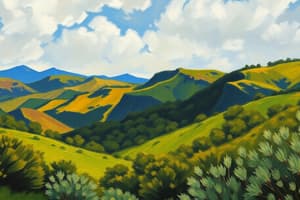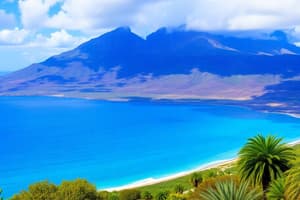Podcast
Questions and Answers
Where is the Canary Islands archipelago located?
Where is the Canary Islands archipelago located?
In the Atlantic Ocean, off the northwest coast of Africa
What is the total area of the Canary Islands?
What is the total area of the Canary Islands?
Approximately 7,447 km²
How many endemic species are found in the Canary Islands?
How many endemic species are found in the Canary Islands?
Over 500
Who discovered the Canary Islands in 1402?
Who discovered the Canary Islands in 1402?
What is the name of the traditional folk music and dance of the Canary Islands?
What is the name of the traditional folk music and dance of the Canary Islands?
What is the name of the famous folk festival in Santa Cruz de Tenerife?
What is the name of the famous folk festival in Santa Cruz de Tenerife?
What is a characteristic of the traditional dance Isa from the island of La Palma?
What is a characteristic of the traditional dance Isa from the island of La Palma?
Which instrument is commonly used in traditional folk music in the Canary Islands?
Which instrument is commonly used in traditional folk music in the Canary Islands?
What is the name of the traditional folk song often performed at festivals and celebrations in the Canary Islands?
What is the name of the traditional folk song often performed at festivals and celebrations in the Canary Islands?
What is a typical ingredient used in traditional Canarian dishes?
What is a typical ingredient used in traditional Canarian dishes?
What is a popular dish in the Canary Islands?
What is a popular dish in the Canary Islands?
What is a staple in many local dishes in the Canary Islands due to its geographical location?
What is a staple in many local dishes in the Canary Islands due to its geographical location?
Flashcards are hidden until you start studying
Study Notes
Geography
- Located in the Atlantic Ocean, off the northwest coast of Africa
- Archipelago consisting of 7 main islands:
- Tenerife
- Gran Canaria
- Lanzarote
- Fuerteventura
- La Palma
- El Hierro
- La Gomera
- Total area: approximately 7,447 km²
- Volcanic origin, with varying landscapes:
- Beaches and deserts
- Mountains and forests
- Volcanic peaks and craters
Biodiversity
- Unique flora and fauna due to geographical isolation
- 500+ endemic species, including:
- Plants: Dragon trees, Canary Island pine, and various succulents
- Animals: Giant lizard, Canary Islands skink, and several bird species
- Important habitat for migratory birds and marine life
- National parks and protected areas cover approximately 40% of the land
Spanish History
- Discovered by Spanish explorer Juan de Bethencourt in 1402
- Colonized by Spain in the 15th century
- Strategic location for Spanish trade and navigation
- Important hub for Spanish colonization of the Americas
- Canary Islands played a significant role in the Spanish Empire's expansion
FOLK (Folk Culture, Folklore, and Folk Music)
- Rich cultural heritage influenced by:
- Indigenous Guanche people
- Spanish, African, and Latin American traditions
- Traditional folk music and dance:
- Isas (polyphonic songs)
- Timple (small, four-stringed instrument)
- Folk dances, such as the Malagueña and the Isa
- Folk festivals and celebrations:
- Carnaval de Santa Cruz de Tenerife
- Fiesta de la Virgin de la Candelaria
- Romería de la Virgen de la Luz
Geography
- Located in the Atlantic Ocean, off the northwest coast of Africa
- Consists of 7 main islands: Tenerife, Gran Canaria, Lanzarote, Fuerteventura, La Palma, El Hierro, and La Gomera
- Total area: approximately 7,447 km²
- Features diverse landscapes due to volcanic origin, including:
- Beaches and deserts
- Mountains and forests
- Volcanic peaks and craters
Biodiversity
- Unique flora and fauna due to geographical isolation
- Boasts over 500 endemic species, including:
- Plants: Dragon trees, Canary Island pine, and various succulents
- Animals: Giant lizard, Canary Islands skink, and several bird species
- Important habitat for migratory birds and marine life
- National parks and protected areas cover approximately 40% of the land
Spanish History
- Discovered by Juan de Bethencourt in 1402
- Colonized by Spain in the 15th century
- Strategic location for Spanish trade and navigation
- Played a significant role in the Spanish Empire's expansion, especially in the colonization of the Americas
Folk Culture
- Rich cultural heritage influenced by:
- Indigenous Guanche people
- Spanish, African, and Latin American traditions
- Traditional folk music and dance features:
- Isas (polyphonic songs)
- Timple (small, four-stringed instrument)
- Folk dances, such as the Malagueña and the Isa
- Celebrates various folk festivals, including:
- Carnaval de Santa Cruz de Tenerife
- Fiesta de la Virgin de la Candelaria
- Romería de la Virgen de la Luz
Folk Culture
- Isa Dance: a traditional dance from La Palma, characterized by rapid footwork and complex rhythms.
- Tajaraste Dance: a style of folk dance from El Hierro, known for its energetic and lively movements.
Music
- Traditional Instruments: timple (a small, five-stringed instrument) and charango (a small, 10-stringed instrument) are commonly used in folk music.
- "Islas Canarias": a traditional folk song often performed at festivals and celebrations.
Cuisine
- Papas Arrugadas con Mojo: a traditional dish of small, wrinkled potatoes boiled in salty water and served with a spicy sauce called mojo.
- Sancocho: a hearty stew made with fish or meat, vegetables, and root vegetables like yuca and sweet potatoes.
- Local Ingredients: gofio, a type of toasted grain flour, is commonly used in Canarian cuisine.
- Fresh Seafood: fresh fish and seafood are a staple in many local dishes due to the islands' Atlantic Ocean surroundings.
Studying That Suits You
Use AI to generate personalized quizzes and flashcards to suit your learning preferences.




